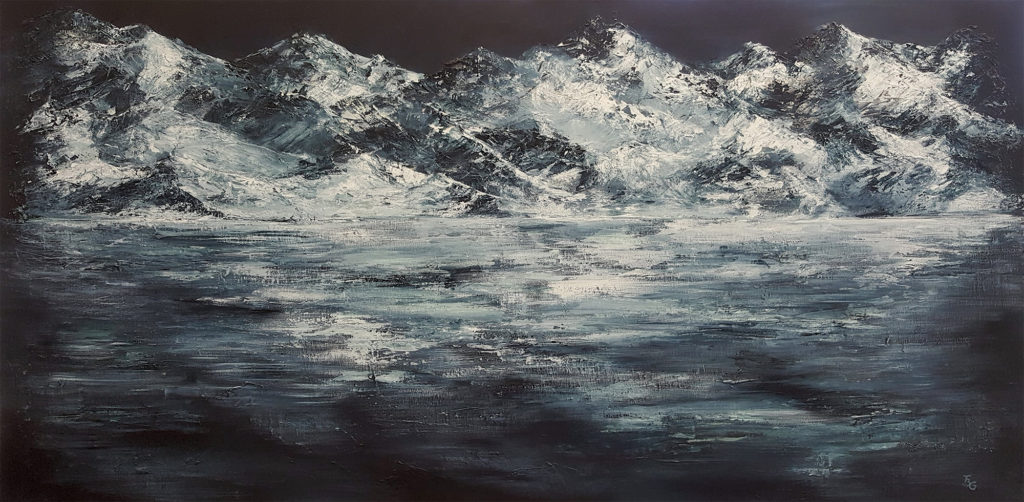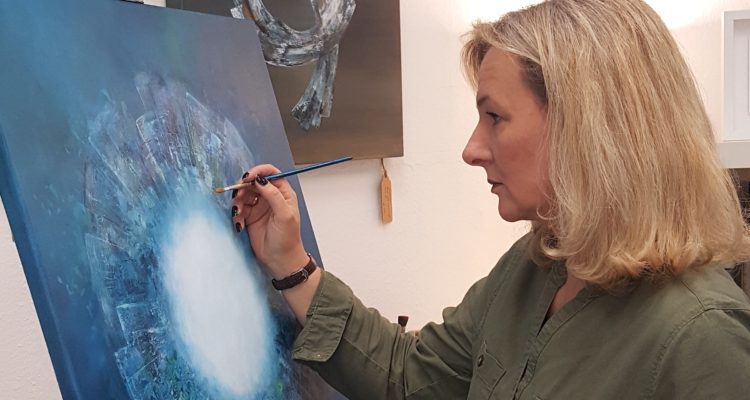“Art is a medium for making personal encounters happen…”
Paul Zimmerman in conversation with Tanja Guntrum
Paul Zimmerman: How did you develop interest in art?
Tanja Guntrum: Since I was a child, I focus on conveying personal experiences via drawings and painting in general. To me it seemed to be the only appropriate medium to deal with my sentiments about strained interpersonal relationships, controversial expressions of opinions or the alternating environment and to depict what I felt. The process of drawing sometimes helped me come up with creative solutions. I tried out other art forms like writing and sculpting, but none seemed appropriate. So painting became an essential part of my life.
PZ: What is the most challenging aspect of your work?
TG: When it comes to painting, I’m an utter perfectionist! I always fight against my self-expectations and the inner need to continually improve a seemingly imperfect painting. But besides the more technical aspects, the real challenge is to match what I feel to what I can display on a canvas. With my artworks, I’m in constant pursuit of a life’s essence, the development, the legacy and it’s evanescence. It’s about the perception and decoding of principles, about the truth behind the obvious. And about my struggle to give these complex actualities a simple jet genuine form.
PZ: What is your artistic process? How do you create your paintings?
TG: I only draw sketches when I prepare commissioned pieces. For my own paintings most often I follow on the spur of the moment, instantly seeing a complete picture in my mind’s eye. These inner pictures are sometimes sparked by personal encounters or a poem I read. But most of the time I’m inspired by music. Significant chord progressions and motifs often directly conduct into an artwork. Sometimes it feels a bit like synesthesia.
PZ: Do you have any particular goal in mind when your start a new piece?
An important goal for me is to allow the viewer to comprehend my subjects without any visual hindrances. The intuitive and unconstrained handling of color gradients as a background for distinctively bordered and isolated forms, which attracts the attention of the observer through color or position. The goal is not to create an artwork that will please most viewers. Most important to me is what kind of emotions or visions my artwork can trigger within the viewer.
PZ: How do you know when the painting is finished?
TG: For a perfectionist like me, this is not an easy topic. When I brought myself to stop working on a painting, I put it away for a couple of days. Then I set it up on an easel in some corner of my studio. Now and then, I walk up to it.
PZ: Have your practice changed over time?
TG: When I was a child, I mostly used carbon pencils. Like many other artists of the 20./21. century I began with figurative motifs before I turned to concrete painting and abstract interpretations. Not until 2005 I discovered the world of colors as an additional layer of expression and turned to acrylic paint.
With regards to content, my work is divided in four artwork assemblages (Anthroposophical, Narrative, Graphical, Eyes). All my artworks have clear references of my core techniques and pictorial vocabulary and show my central theme of the ‘Schöne Linie’ (means ‘beautiful stroke’), which can be found in composition elements or graphic lines. But regarding the subjects of my paintings, I developed the above-mentioned artwork assemblages, which built upon each other and are in a constant process of development.

PZ: Which artists are you most influenced by?
TG: In my early years I often was influenced by opera (Aida, La Traviata, Madame Butterfly) and the imaginative worlds of fantastic literature (Jules Verne, Saint-Exupéry, Tolkien). Later on, when I’ve occupied myself with art history and theory, I become influenced by a couple of specific artists like Monet, Mondrian, Malewitsch and Kandinsky, speaking of their oevre as well as their biography.
PZ: How would you define art?
TG: To me art is a medium for making personal encounters happen, art should be a seed crystal for the exchange of emotions and visions. And art can also be a source of beauty.
PZ: What are you working on now?
TG: Currently I’m setting the schedule for the next year. I will participate in exhibitions in Vienna and Zurich, and therefor I’m working on a sequel of my “Silence” series (abstract mountain motifs). Furthermore, I’m working on two paintings that will reflect my current life situation.
PZ: How does the pandemic influence your work and sensibility?
TG: Essentially, I’m an introverted person, that can be for his own quiet well. But the longer this pandemic lockdown goes on, the more I miss the personal contact to my students and fellow artists, attending exhibitions and working on joint projects with other artists. It’s the overall lack of the creative multiplicity and getting in contact with something new. On the other hand, I try to make the best of the declined work load. I always try to reflect on the past and things past recovery to be prepared for the future. I’m developing projects that on the one hand will reflect the current problems, the unprecedented constraints and latent fears. And on the other hand the new options that arise, the maybe once-in-a-lifetime chances to fundamentally change our societies and paths of development. To incorporate this duality in a single painting is a challenge, I’m trying to master.
